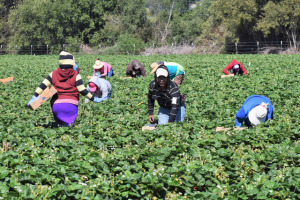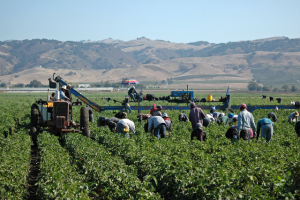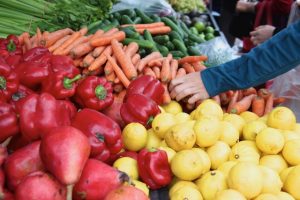Opening Remarks For Changemakers Day During Slow Food Nation
August 30, 2008 Michael R. DimockFollowing are three sets of opening remarks delivered by Michael Dimock at three panels of Changemakers Day during Slow Food Nation on August 29, 2008.
Panel: Network Power and Food Politics in the Connected Age
Thank you all for coming to Network Power: Food Politics in the Connected Age. My name is Michael Dimock and I am president of Roots of Change. Roots of Change is a collaborative of diverse leaders and institutions unified in common pursuit of a sustainable food system in California by the year 2030. As a coordinating entity across government, non-profit and business sectors, Roots of Change works to maximize the synergy available to those transforming the food system by convening multi-stakeholder planning sessions and supporting collaborative implementation with grants, fellowships, and contracts. Roots of Change is a sponsor and co-organizer of Changemakers Day and we are thrilled you are all here.
In the next 75 minutes using dialog, among panel members and the audience, we hope to answer the following question: Can complex collaborations be successfully developed and maintained as we work to transform the food system?
Let me introduce our panel.
Holly King is the Director of Agricultural Programs for the Great Valley Center.
Joseph McIntyre is Executive Director of Ag Innovations Network, one of my favorite organizations.
Dr. Howard-Yana Shapiro is Global Director of Plant Science and External Research for Mars as well as the leader of the Multi-disciplinary Research Unit involving Mars, University of Nottingham in England and the University of California, Davis.
Dr. Tom Tomich is the founding Director of the Agriculture Sustainability Institute at University of California, Davis, the Director of University of California’s Sustainable Agriculture Research & Education Program and holds the W.K. Kellogg Endowed Chair in Sustainable Food Systems at UC Davis.
All four of our panelists are involved in building and maintaining complex collaborations.
Before beginning the dialog, I want to share why this question of collaboration sits before us today.
We live in the age of the Internet, characterized by networks and increasingly distributed leadership. Networks are used for communication and commerce, social activism, and even terrorism. Our world faces incredibly complex health, environmental, cultural and economic challenges. Polarized communities abound. We are bombarded with information and calls to action. Individuals are highly self-directed, less influenced by “authority” and science and scientists seem less and less able to provide clarity on what must be done. And the complexity in the form of cultural diversity is increasing in most communities. At the same time, governments at all levels seemed locked in stalemate and even if they are not, bureaucracies are slow to adapt.
Given these realities, many people seeking food system transformation face a question: how do we align enough people, enough policy, enough action, enough money to actually accelerate change?
In her book, Momentum: Igniting Social Change in the Connected Age, Allison Fine argues that we live in a extreme period of self-determination, where unprecedented numbers of people have unparalleled level of choice around work and pleasure. We also have unimagined levels of connectivity through cell phones, PDAs and personal computers. Yet, many activists feel trapped by the need to meet the expectations of governments, foundations and contributors who supply the money. She calls on all of us to be brave, have faith, and to define our own meaning for success and then reach out with the communication tools that exist to form networks of aligned people.
She believes there are key methodologies, cultural norms and tones of communication that are essential to forming networks that can move and evolve rapidly. She also believes that network managers must focus on the edges of the network to drive growth and ignite the changes they seek. By edges she means the space between your core connected people and those just beyond it. Like a root of a plant, the network must have energy to manifest new cells. But in contrast to a root that grows from the inside out, a network must expand through attraction or accretion of people just beyond the edge, who are sucked in by messaging or action.
It is a nice idea, a nice concept. But hard to accomplish particularly when working in food systems where there are many communities that live beyond a digital or cultural divide. The complexity in food systems is not just about the biology of production, the geography of distribution, the economics of eaters, or the nutrition of a meal; it may be mostly about the culture of communities, the paradigms of people, the politics of class.
Working in food systems, we are working at the root system of civilization and making progress often seems a tough row to hoe. So today, we will ask the panel and then you all to help us define what is needed to align the complex forces at work in the food system. And with the aid of a computer, a projector and a screen we hope to create an actual list of guiding principles for building successful complex collaborations.
So in the 65 or more minutes remaining, let’s dialog…
***
Panel: Exploring the Meaning of Clean
Thank you all for coming to Exploring the Meaning of Clean.
In the next 75 minutes using dialog, among panel members and the audience, we hope to answer many important questions, including:
Is organic the only clean or in what other ways do we define clean? What is clean enough and who should be the arbiter of clean?
How do we ensure that low income people can also afford food that is clean?
Let me introduce our panel:
Linda Brown is the co-founder and Executive Vice President of Scientific Certification Systems or SCS.
Scott Exo, is the executive director of Food Alliance.
Jonathan Kaplan leads the Natural Resource Defense Council’s Sustainable Agriculture Project.
Karen Ross is the President of the California Association of Winegrape Growers.
Before beginning the dialog, I will take three minutes to frame the discussion.
Slow Food has declared the goal of creating a good, clean and fair food system. Good means food has a welcome taste as defined by ones own culture and gives pleasure to the eater. Fair means that those who harvest and work the land or in food manufacturing plants are treated with dignity and respect and are fairly compensated for their endeavors. Despite what many of us may think, clean may actually be the toughest of these three characteristics to define.
On the surface it means food results from farming practices that do not foul soil, water, air and living tissues of plants, livestock and humans. But how do we measure this? Science and experience tells us that in certain cases long time frames are required to know the true costs and impacts of a farming practice. The world is full of battles between farmers and environmentalists each claiming their science supports their position on a given pesticide or chemical input. Although some will not agree, organic farming is generally seen as the cleanest, but there is still too little available and it is perceived as too expensive for many people. So if we all agree that today not enough farming is clean enough, what options do we have to move forward? How do engage producer resistance to wider and faster adoption of clean farming in order to lower their risks and enhance the rewards? The panel is aware of many options, many ways of thinking about this issue. So let us begin.
***
Panel: Linking Urban and Rural as a Basis for a Good, Clean and Fair Food System
Thank you all for coming to Linking Urban & Rural as a Basis for a Good Clean & Fair Food System. In the next 75 minutes, using dialog, among panel members and the audience, we hope to answer the following questions:
How are urban and rural communities interdependent?
What is a foodshed?
Is a foodshed like a watershed?
What makes them different?
What is needed to make the idea of foodshed stewardship or management as practical and ubiquitous and watershed management?
The dialog will begin with the panel and will then be opened to include all of you at no later than 3:40 pm. We must end promptly at 4 to allow the next session to prepare.
So let me introduce our panel:
Sibella Kraus is the president of SAGE (Sustainable Agriculture Education) a nonprofit with the mission to broaden the constituency for sustainable regional food and agriculture. SAGE works to develop agricultural parks, public and farmer’s markets, and agricultural education.
Paul Muller and his wife Dru Rivers are partners in Full Belly Farm in the Capay Valley of Yolo County to our east.
David Pascal is with the Office of the Mayor in the City of San Francisco and is also the Green Technology & Green Business Advocate with the City’s Department of the Environment.
Edward Thompson, Jr., is the California State Director for the American Farmland Trust.
Before, we begin with the panel, let me take a moment or two to frame this issue a bit.
Urban centers exist and thrive when rural regions produce a surplus of food and fiber. When civilizations forget this dependence and under invest in the health and wellbeing of their surrounding rural regions, collapse is inevitable. Examples of this relationship, and consequences from its break down can be found in the works of Allan Savory, the evangelist for holistic management, Edward Hyams’, Soil and Civilization, and the more recent Collapse by Jared Diamond and the End of Food by Paul Roberts.
This relationship is a two-way street, and rural communities depend on urban centers for markets, capital, and good policy, though today they might describe themselves as vulnerable to the whims and wishes of urban centers. There is actually significant tension between urban and rural communities. Fights over water and air quality, land use regulations, and pesticide use often reflect urban-rural splits.
There are signs of improvement in rural and urban relations. In recent years natural and human derived resource flows have begun to highlight the important opportunities for recognizing mutually beneficial links. Cities and urban-based philanthropies have supported land trusts and agricultural land preservation projects that protect farmland. At least one metropolitan area in California, Sonoma County, with over half it population in the city of Santa Rosa, has even taxed itself to do this!
Rural regions practicing good watershed stewardship ensure cities have clean water to drink. Cities practicing good water treatment are beginning to supply farmers with recycled water for crop irrigation. Cities that practice green waste collection and compost that valuable resource provide a soil amendment that is good for improving farmland. Rural regions that focus on eco- or agritourism provide urbanites with spaces and places for recreation and leisure. Cities that value fresh healthy produce provide sites and support for farmers markets and wholesale distribution. A healthy symbiosis can exist when urban and rural people understand and foster healthy resource flows.
I want to admit my bias up front, since I am moderating. This is a bias shared by my colleagues at Roots of Change. We feel it is vital to reawaken both urban and rural people to their interdependence. More cities could provide economic incentives for farmers willing to preserve agriculturally productive land in zones around the city, thereby ensuring sufficient local land to feed their populations. More cities could supply water and compost to farmers and expand the direct marketing opportunities for local farmers. More farmers could practice watershed stewardship and develop agritourism. We could all do more to ensure the urban-rural relationship is dynamic and supportive of sustainable civilization.
As I mentioned, with help from this panel and Hannah Laurison from Public Health Law & Policy, Larry Bain of Food from the Park and Paul Jones, from the San Francisco Department of Public Health, the City of San Francisco will hold a series of three roundtable meetings involving 15 leaders from the country and 15 from the city. Their mission will be to discuss how both sides could develop a foodshed-oriented relationship that benefits both communities. Mayor Gavin Newsom and California’s Secretary of Agriculture, AG Kawamura, will both participate. This work will begin on October 22nd with a meeting at UC Davis.
With that as background, I would like to turn to the panel with a first question…



